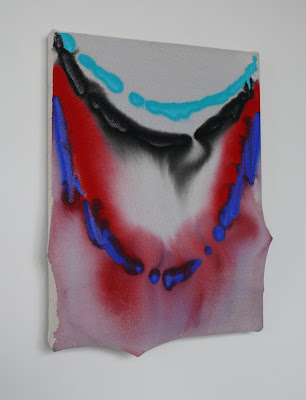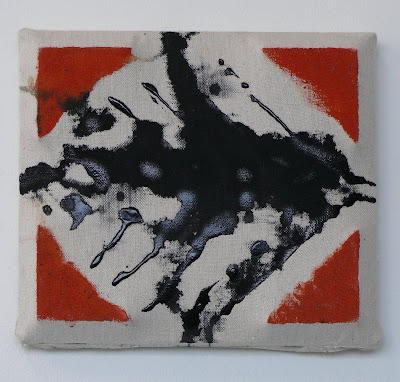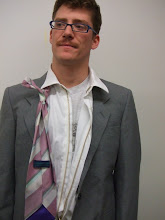Jonathan Allmaier & Maria Walker
View from gallery entrance.

Maria Walker
First Things First. Acrylic on canvas, 2008.
Jonathan Allmaier
I Did Not Parade the "Colors". Oil on canvas, 2007.
Jonathan Allmaier & Maria Walker
Installation view
Jonathan Allmaier
You Can Try to Have a Nice House, But What Can You Do? Oil on canvas, 2007.
Maria Walker
Untitled. Acrylic on canvas, 2008.
Jonathan Allmaier & Maria Walker
Installation view
Jonathan Allmaier
You Know There Are Two Distances in Your Distance. Oil on canvas, 2007.
Maria Walker
Untitled. Acrylic on canvas, 2008.
Jonathan Allmaier & Maria Walker
Installation view.
Jonathan Allmaier
AMERICAN: Address the Need For a Culture By Starting the Painting Earlier. Oil on canvas, 2008.
Jonathan Allmaier & Maria Walker
Installation view.
Maria Walker
Jonathan Allmaier
One Way is the Amazon River (Dangerous) Behind a Grate, the Other is the Pacific Ocean. Oil on canvas, 2007.

Maria Walker
Untitled. Acrylic on canvas, 2008.
Maria Walker
Sleepwalker. Acrylic on canvas, 2008.
Maria Walker
X. Acrylic on canvas, 2007.
Johnathan Allmaier
Banquet of the Starved. Oil on linen, 2008.
Jonathan Allmaier
It's Time to Look Past Compositional Style as a Model of History. Oil on canvas, 2008.
Jonathan Allmaier
Be Specific About the Gap Between What and What in the Mind. Oil on canvas, 2008.
Maria Walker
Untitled. Acrylic on canvas, 2007.
Maria Walker
Slo Mo. Acrylic on canvas, 2007.
Jonathan Allmaier & Maria Walker
Installation view.
Jonathan Allmaier & Maria Walker
Installation view.
Jonathan Allmaier
Vincent, You Stay Away From My Daughter. Oil on canvas, 2008.
Jonathan Allmaier
Round Plus Square (What is the Source of Ritual, What is the Nature of Community). Oil on canvas, 2008.
Maria Walker
Untitled. Acrylic on canvas, 2008.

Jonathan Allmaier
A Man Providing For The Family. Oil on linen, 2007.

At the reception for the artists, March 15, 2008.

Kevin A. Curran interviews Maria Walker and Jonathan Allmaier:
KAC: Maria, you did not title many of your pieces, what's up with that? What do you think is the function of the title? What happens when there is no title? I think I am harping on the title issue because that was one of the big contrasts I noticed as I entered the info on the blog. It is interesting to me how much Jon has going on with his titles and you seem reluctant to put words to your work. Can language introduce an artwork? Do you think it is better for the audience to bring their own words to your work? Like: Stretched, Poked, Stained, Drips, Dots, Raw canvas, etc.
MW: I am not reluctant to title my paintings. I am just very careful in deciding on what the title for a painting is, and deciding on a title often takes time for me. Some titles are very clear, and I know what they will be even before the painting is made. Some paintings I know may have a title, but I need to work and wait at figuring out what that title is. And then some paintings just do not have titles.
When I title a painting, I’m looking for a title that engages, but doesn’t impede the experience of looking. I think of the titles like puzzles, and I’m working on solving the right balance between the title and the painting, in which the painting is brought forward as clearly and luminously as possible. There’s a dance and resonance between the two. The titles usually come from the process (rules, logic, order, and surprises in the work), personal associations, or source material. They may come from the experience of what it was like to make the piece.
Titles are tricky, though, and a bad title can shut down a painting. I would rather leave a painting untitled and let it come forward as its own, clear self, than muffle it up with a rushed, bad title. There were some very recent paintings in this show for which I simply still don’t know what the titles are. When I decide to leave a painting untitled, it’s because I feel like it comes forward most clearly without any words in conjunction with it. For these paintings I feel like I can’t think of a title that wouldn’t start to shut down the painting in some way.
KAC: Your pieces point out their structure and their process. So the language I come up with looking at your work is about these actions that distort the canvas and its skeleton. It is physical work.
MW: The making of the paintings works as a series of rules that combine with intuition, creating a puzzle-like process full of risk, instinct, distance, parameters, and analysis. The paintings are not all process, though. The process is a way to get to/ access something a kind of thinking I could not arrive at otherwise. When I paint, I am pushing to arrive at a different kind of relationship to myself and to the painting; this is a point where each opens up in new, unexpected ways.
KAC: How do you select color? How do colors relate to one another and to the canvas? What is color doing in your paintings?
MW: I work from a similar balance between rules/parameters and intuition when thinking about color. With color, I am interested in both how I can mentally work my way through a painting by subjectively making choices about color, and also what happens when I displace where the choices about color are coming from (for example, by setting up some kind of rule system). I find that color works best when it is essentially part of the painting just like any other element of the work—the canvas, the stretcher, the physical substance of the paint. The same goes for the stretchers. I want the paintings to work as singular objects, with each separate element combining to create something at which point the stretcher on its own or the color on its own isn’t more interesting on removable that the whole, singular thing.
KAC: What is boring about a regular stretcher? How do you go about crafting your stretchers?
MW: I have nothing against a traditional rectangular stretcher, and actually the subtleties of the nuances of a “regular stretcher” are profound. I began painting on these “shaped” kinds of stretchers because their change of structure helped me start painting more freely. Their very physical nature, combined with the kind of rule-based method I had started working with allow me to enter a painting more clearly, and access the kind of displaced thinking I addressed earlier.
When building the stretchers, I focus on thinking about what kind of surface and structure I want to work with. What kind of surface do I want to touch? What kind of questions about materials and painting do I have right now, and what kind of structure/frame/stretcher will best help me explore that? I get very involved in building the stretchers. I have been using scraps from old stretchers, leftover pieces of wood from the saw, etc, etc. This wood has been important to me, since it creates a limitation in and of itself to work with. How the stretchers change and develop often leads one to the next, and I’ll make several at one time. Other times, the idea for the stretcher comes with lots of thinking about a particular painting.
KAC: How do you and Jon decide how to arrange your work together in the same space?
MW: Jon, Amy, and I decided how to hang our work by thinking about what would make the best show. We considered each piece and what it needed, and went from there.
KAC: Jon, how do the titles of your work relate to the image?
JA: There is not generally much of an image, or that’s not how I think of the paintings.
KAC: What do you think is the function of the title? Does the title add something to the image?
JA: The title doesn’t add anything per se, as far as I know, either to the painting or to its image. The title exists parallel to the painting – it is the result of a parallel process to the process of making a painting. Like having a show, the title is an important part of the life of the painting, but it is not made of the same stuff as the painting. Still, not unimportant.
KAC: Can language introduce an artwork?
JA: In the case of painting, I don’t think so. Language and painting are such fundamentally different things, language being so necessarily abstract. Painting can’t be abstract in the same way. It has to have particular physical properties. You could talk about images in terms of language, but not paintings. The one way that painting can be abstract is in the really traditional sense – in the regularity and predictability of the more or less flat thing on the wall. But that is a different type of abstraction that what you get in language. It’s not as purely abstract, but enough to develop a history and a community. Maybe better for developing those things, in some ways, because it’s not as purely abstract.
KAC: How does scale function in your paintings? I mean the scale of the canvas but also that of the color forms and fields and the marks in the image.
JA: I had been doing small paintings for a while because, when you think of a small painting, the space of a small painting is a mental space. The idea of a small painting is a mental idea. That was the kind of idea I was interested in at that point. But the physical properties of the small stretchers I built, and the paint I used, and the fact that the canvas itself stayed pretty present on the small size, meant that the scale of the canvas, forms, and paint was a pretty physical scale. It goes to show that the body is not reducible to gesture, but shapes our thoughts too.
I’m doing big paintings now, trying to think about color very directly, in a very mental or imaginative way, and apply that large physical space to the mind, having learned something from the smaller paintings.
KAC: How do you select color?
JA: In terms of scale. It’s interesting to really try to make color the primary thing, to make the color generate the scale and the drawing. The main things in terms of selection, or a way of starting, are the size and shape of the canvas, and the color. I’m interested in painting where the color is indistinguishable from the scale and the drawing.
KAC: How do colors relate to one another and to the canvas? What is color doing in your paintings?
JA: Not for me to say.
KAC: How do you and Maria decide how to arrange your work together in the same space?
JA: My approach is to pick the painting I want to hang, and then see where that painting ought to go.
KAC: What is boring about using manufactured paint?
JA: Nothing is categorically boring about it. I prefer making my own paint because that way I know what the paint is, in terms of the pigment it comes from and the way that pigment took the oil to become paint. There will always be some kind of mystery waiting for you about your pigment, even if you made it yourself by grinding up tree-bark or bugs, or used dirt. But making the paint makes the mystery a less arbitrary mystery, because the process of making it has to do with how you are going to use it.
KAC: What qualities are you trying to produce in the paints that you craft?
JA: You can’t try to produce any qualities, just try to make the best paint you can (I define that as using as little oil as possible). The pigment is not up to you, it’s a physical object. Of course, my paint would be different from yours, but only because painting is not that purely abstract.
KAC: What is the significance of intimacy with your raw materials?
JA: See above.
KAC: Why do you reveal the stretcher below the surface by letting it become part of the image?
JA: This is mostly because I like thin stretchers. When I make my own stretcher, the most straightforward way to make a good thin stretcher is to leave off the lip. But fancier stretchers will also show themselves sometimes if they are thin. I like a thin stretcher because it is all you need to stretch a canvas, and because it affects the scale of the canvas (and then the paint) in relation to the stretcher, and to the wall. This is a type of scale that tends to keep the painting unified as (necessarily) that particular thing. You could say that canvas itself is thin, and so is paint, and so a stretcher that stays closer to that level of thickness creates a complexity of scale.
Many thanks to Maria and Jon, and to Amy Lincoln for an excellent show.
Kevin A. Curran
March 2008.

































No comments:
Post a Comment